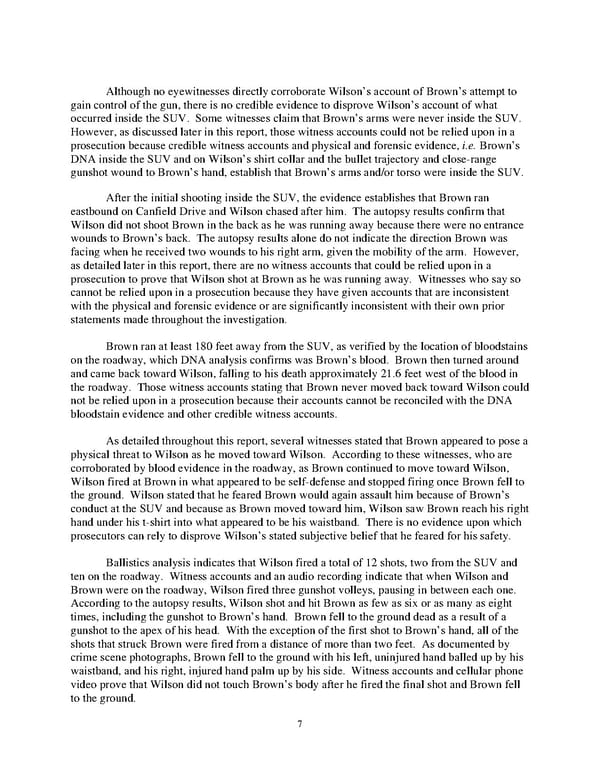Although no eyewitnesses directly corroborate Wilson’s account of Brown’s attempt to gain control of the gun, there is no credible evidence to disprove Wilson’s account of what occurred inside the SUV. Some witnesses claim that Brown’s arms were never inside the SUV. However, as discussed later in this report, those witness accounts could not be relied upon in a prosecution because credible witness accounts and physical and forensic evidence, i.e. Brown’s DNA inside the SUV and on Wilson’s shirt collar and the bullet trajectory and closerange gunshot wound to Brown’s hand, establish that Brown’s arms and/or torso were inside the SUV. After the initial shooting inside the SUV, the evidence establishes that Brown ran eastbound on Canfield Drive and Wilson chased after him. The autopsy results confirm that Wilson did not shoot Brown in the back as he was running away because there were no entrance wounds to Brown’s back. The autopsy results alone do not indicate the direction Brown was facing when he received two wounds to his right arm, given the mobility of the arm. However, as detailed later in this report, there are no witness accounts that could be relied upon in a prosecution to prove that Wilson shot at Brown as he was running away. Witnesses who say so cannot be relied upon in a prosecution because they have given accounts that are inconsistent with the physical and forensic evidence or are significantly inconsistent with their own prior statements made throughout the investigation. Brown ran at least 180 feet away from the SUV, as verified by the location of bloodstains on the roadway, which DNA analysis confirms was Brown’s blood. Brown then turned around and came back toward Wilson, falling to his death approximately 21.6 feet west of the blood in the roadway. Those witness accounts stating that Brown never moved back toward Wilson could not be relied upon in a prosecution because their accounts cannot be reconciled with the DNA bloodstain evidence and other credible witness accounts. As detailed throughout this report, several witnesses stated that Brown appeared to pose a physical threat to Wilson as he moved toward Wilson. According to these witnesses, who are corroborated by blood evidence in the roadway, as Brown continued to move toward Wilson, Wilson fired at Brown in what appeared to be selfdefense and stopped firing once Brown fell to the ground. Wilson stated that he feared Brown would again assault him because of Brown’s conduct at the SUV and because as Brown moved toward him, Wilson saw Brown reach his right hand under his tshirt into what appeared to be his waistband. There is no evidence upon which prosecutors can rely to disprove Wilson’s stated subjective belief that he feared for his safety. Ballistics analysis indicates that Wilson fired a total of 12 shots, two from the SUV and ten on the roadway. Witness accounts and an audio recording indicate that when Wilson and Brown were on the roadway, Wilson fired three gunshot volleys, pausing in between each one. According to the autopsy results, Wilson shot and hit Brown as few as six or as many as eight times, including the gunshot to Brown’s hand. Brown fell to the ground dead as a result of a gunshot to the apex of his head. With the exception of the first shot to Brown’s hand, all of the shots that struck Brown were fired from a distance of more than two feet. As documented by crime scene photographs, Brown fell to the ground with his left, uninjured hand balled up by his waistband, and his right, injured hand palm up by his side. Witness accounts and cellular phone video prove that Wilson did not touch Brown’s body after he fired the final shot and Brown fell to the ground. 7
 DOJ Report on Shooting of Michael Brown Page 6 Page 8
DOJ Report on Shooting of Michael Brown Page 6 Page 8